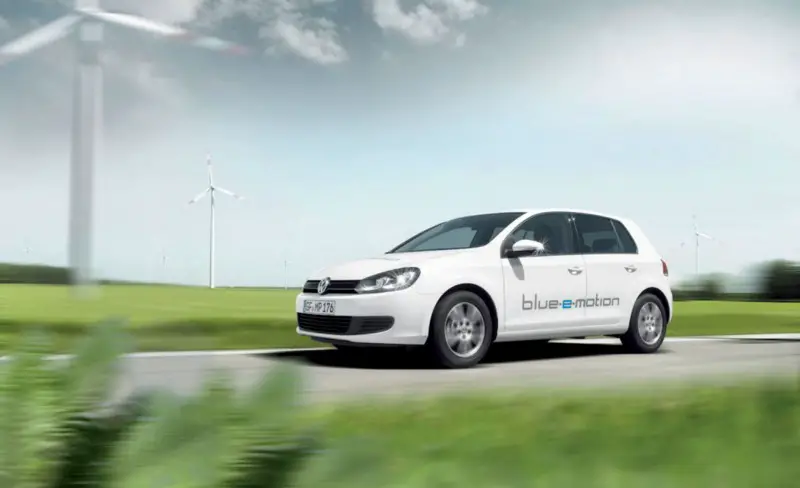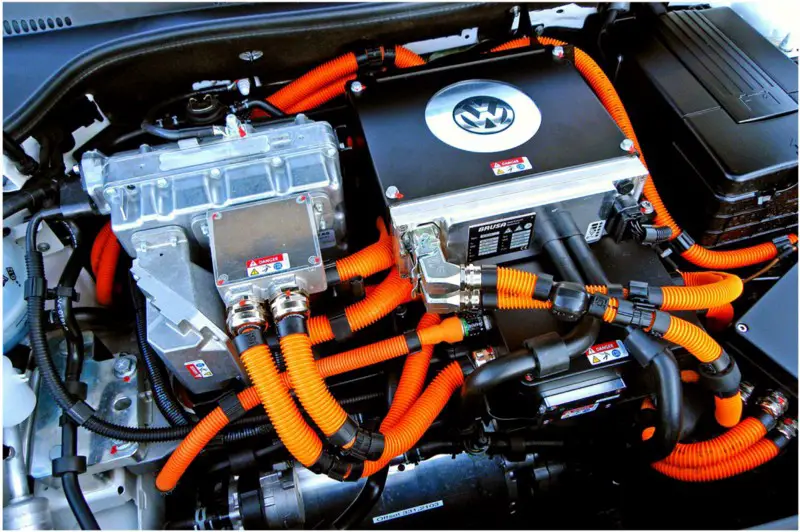Volkswagen Golf Blue-E-Motion Electric Car
The five-door and five-seat Golf blue-e-motion is silently driven by an electric motor that delivers a high maximum torque (199 lbs.-ft.)…


The five-door and five-seat Golf blue-e-motion is silently driven by an electric motor that delivers a high maximum torque (199 lbs.-ft.) from a stop, resulting in a true zero-emissions Volkswagen driving experience. The electricity for powering the electric motor is stored in a lithium-ion battery with an energy capacity of 26.5 kilowatt-hours. The Golf blue-e-motion joins Volkswagen’s many other responsible mobility options, including TDI Clean Diesels, hybrids and bio-fuel powered vehicles.
The Golf blue-e-motion features a driving range of up to 93 miles; however, the specific range will depend on driving style and factors such as the use of air conditioning and heating. The aerodynamic Golf blue-e-motion offers ample power and has features that ensure energy is preserved while driving. For example, the vehicle can coast or sail, whenever the driver releases the electric pedal. The motor is then controlled to the zero-torque curve, allowing the car to coast down the road with the least possible drag. The Golf blue-e-motion also recovers kinetically generated energy through brake regeneration.
Consisting of 180 lithium-ion cells, the Golf blue-e-motion 30 battery modules can be found in the trunk floor, under the rear bench seat and between the front seats. A separate air-cooling system ensures a constant thermal environment in the battery compartment.
The driver can determine the amount of energy demanded by the electric pedal from the kW gauge, which replaces the classic tachometer. A range indicator is also integrated in this round instrument. The speedometer, which is located on the usual right side, integrates another small gauge that provides information on the battery charge state.

A new feature is the display of regeneration intensity in the multi-function display (MFD) between the kW instrument and the speedometer. In battery regeneration, the driver has the option of pre-setting the braking energy recovery strategy over four stages via the automatic gearshift lever or the gearshift stalk on the steering wheel (D to D3). In the lowest stage (D), the car moves as soon as the driver’s foot leaves the pedal, slowed only by the rolling resistance of the tires and air resistance. In the D3 stage, the maximum amount of kinetic energy is recovered and fed to the battery. In addition, the electrical energy consumption of the automatic climate control system and its blower is shown in the multi-function display.
An active driving profile can also be set, allowing the driver to select between maximum range, maximum comfort and maximum dynamics in advance. The selected profile then pre-configures the power of the electric motor, air conditioning control, maximum speed and battery regeneration strategy.
The exterior designs are unique to the Golf blue-e-motion, all key primary and secondary drive components are integrated in the engine compartment at the front of the vehicle. The Golf blue-e-motion, shows off the Volkswagen brand with a front-end design that includes a wide, double-bar grille that blends into angled halogen headlamps for a sportier visage. The body-colored bumper sits above a revised lower front fascia featuring a wide-mouthed cooling duct. Crystalline oval fog lamps complete the front fascia on TDI models. Black window trim and the absence of side moldings keep things simple along the sides for a cleaner look that remains pleasing to the eye. Heading to the rear, a hatch spoiler with integrated third brake light sits atop the hatch and is painted to match the rest of the body. Taillights mimic their counterparts from up front and feature integrated clear turn signal and reverse indicators along the bottom edge. Running reflectors are blended into the lower rear bumper, which adds a blacked out insert and a cutout for a pair of exhaust tips.
On the inside, the Golf blue-e-motion carries its refinement throughout with a variety of stylish touches that aim to keep drivers and passengers comfortable. All models start out with eight-way manually adjustable sports seats at the front, which include two-way adjustable lumbar support, and adjustable head restraints. The rear seats include adjustable head restraints for all seating positions, a center armrest, and have 60/40 split folding capability for maximizing cargo space when needed. Both the front and rear seats come standard with Volkswagen’s “Titan Black” cloth fabric. Brushed metallic appearance trim inserts are standard on the dash and in the door panels of all Golf models and accent the redesigned instrument panel and center console. Chrome trim surrounds the tachometer on the left side, which incorporates an integrated temperature gauge, and the speedometer on the right, has an integrated fuel gauge. Located between the black analog gauges is a multi-function onboard computer display that provides the driver with key information regarding the selected gear, odometer and fuel gauges.

The Golf blue-e-motion is charged via a plug connector behind the folding VW logo on the radiator grille. A pictogram of a plug connector in the multifunction display indicates that the charging cable is correctly inserted and locked. During active charging an LED also flashes in the charge state indicator, and the charge level shown in the indicator is continually updated.




